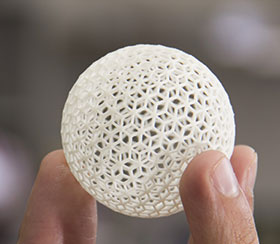

Over the next five to ten years, additive manufacturing (AM) will become the standard manufacturing technology. Innovative designs enabled by generative design methods based on AI algorithms and the use of new materials will become common when removed from the constraints of traditional manufacturing processes. Additionally, these designs will be part of a continuously improving process of production efficiency and optimisation. AM and its complementary technologies will allow for more consolidation of individual parts, and a more streamlined manufacturing process overall, with these designs requiring less assembly time and reduced maintenance in the field.
One area where AM is evolving significantly is in direct manufacturing. This where, due to the advancement of the next generation of 3D printing machines, AM is beginning to be adopted for more volume production capacities. As more companies produce printed parts in larger volumes, and at scale, the price points for additive technology and materials continues to drop. Moreover, as printing techniques and part resolution continuously improve, and newly developed ‘digital’ materials consisting of tuneable micro-structures emerge, this will usher in a new dimension of applied material science and advanced production processes.
Generative design is changing the additive manufacturing process
Generative design is an iterative process that generates multiple design outputs that meet predefined constraints and requirements for fit, form and function. One of the primary benefits of generative design is that it is a fast method for exploring multiple design possibilities. For example, this design technique allows many hundreds, if not thousands, of possible solutions to be evaluated in a relatively short timeframe.
This is possible because generative design is based on AI. Using machine learning techniques and algorithms developed for iterative pattern matching, many variations of designs can be developed based on a primary set of constraints, allowing the designer to evaluate many designs to find the optimal one that fits the requirements. This generative design process is made to order for AM. Engineers can focus on a variety of constraints, such as light-weighting, optimal strength to weight ratio, fit, and a number of functional requirements that best meet the design requirements.
Today’s AM technology, such as with leading PLM solution providers, is leading the way with comprehensive generative design solutions developed specifically for the AM process, from part design to manufacturing. These AM solutions approach the process from a lifecycle perspective, starting with the specific part requirements for specific industries, such as automotive, aerospace, medical equipment, and even consumer goods. The lifecycle begins with discovering the right material and the application with in-silico materials simulation engineering to find the optimal compound. Next is function-driven generative design, followed by the manufacturing process definition and production planning of the part.
Advanced simulation technology validates AM produced parts
Simulations of the additive process are crucial in assessing the finished part’s overall quality and conformance to design requirements. Much of the attention has been focused on powder bed metal fusion processes, as industries work to bring certified parts to market. These simulation models are primarily based on finite element analysis methods and rely on predefined libraries (based on scanning strategies) or thermal strains that function as inputs to relatively fast computations of the part distortions. These simulation methods are reasonably simple to use and do not require the user to have deep knowledge in the physics of the simulation.
Another approach relies on a fully thermo-mechanical solution to the simulation process. Scanning technologies can be used in thermo models to predict the thermal profile as the part is being built, layer by layer. The thermal profiles then drive the mechanical simulations (finite element analysis) for a more accurate prediction of part distortions. The primary advantage of this method is that the fidelity of the simulation can be accurately controlled.
Multiple machines, processes and materials define the AM environment
AM has witnessed strong growth, especially as its focus has shifted from prototypes to functional production parts with an increasing capability to scale and increase volume. However, there remain in place a set of critical production challenges for the industry, including build repeatability, process stability and yield rates. More advanced digital tools are helping to resolve some of these issues: generative design, functional lattices, build planning hardware integration, thermal distortions, and shape compensation.
The AM environment today has expanded significantly in terms of the multiple techniques and technologies that have been established to meet the range of industry requirements and material needs. In a powder bed fabrication process, for example, thermal energy selectively fuses regions of a powder bed. Conversely, in a binder jet process, a liquid bonding agent is deposited to join the material powder. In a direct energy deposition process, a nozzle that is mounted on a multi-axis arm deposits molten material, and in photo polymerisation, liquid photopolymer is selectively cured by light-activated polymerisation. While each process family uses a different raw material supply form (e.g. powder, wire feed, liquid resin, ink), each process family manufactures parts consisting of different material types. For example, powder bed fabrication produces metallic and plastic parts; binder jetting produces metallic, plastic, and ceramic parts; material extrusion produces plastic and composite parts. AM will continue to expand production and fabrication of parts across multiple industries using a full range of technologies and science.

© Technews Publishing (Pty) Ltd | All Rights Reserved